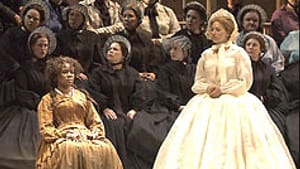Stay in the Loop
BSR publishes on a weekly schedule, with an email newsletter every Wednesday and Thursday morning. There’s no paywall, and subscribing is always free.
OCP's Margaret Garner

DANIEL WEBSTER
Composers, beware the Pulitzer Prize winners, the Nobel laureates. They’ll steal your art away. They’ll woo you with poetry, metric guile, the rhythmic batting of eyelashes and leave you seduced and abandoned with an opera ever after referred to by the poet’s name, not yours. You find yourself billed after Tennessee Williams in Streetcar Named Desire, or Eugene O’Neill in Mourning Becomes Electra.
So it was on Friday (Feb. 10) when the Opera Company of Philadelphia performed the East Coast premiere of Toni Morrison’s and Richard Danielpour’s Margaret Garner at the Academy of Music. A powerful, brutal tale that tears away the romanticized mask of slave life in America, Garner is the stuff of great opera. Textually, it builds a straight dramatic line. It creates words for big choral outcries, concise scenes perfectly designed to frame the heroic aria, the love duet, the searing ensembles that define a decadent society. The text flows and leaps, its rhythmic determination unstoppable. Tragic characters evolve; the story horrifies with implication. It silences its audience with such raw emotion that listeners admit guilt by association to all charges. Arias sometimes ended in near silence. Who could cheer his own indictment, after all?
It’s a firestorm onstage. The production, designed by Marjorie Bradley Kellogg for collaboration by the Opera Company of Philadelphia, the Michigan Opera and the Cincinnati Opera Company, enlarged the drama. Gables widened to suggest the slave owner’s expansive mansion and narrowed to mirror the life of slaves. The owners wore black or white; the slaves wore tans and grays, muffled shades reflecting the owning classes’ view of their slaves’ humanity. Margaret Garner’s deep red kerchief spoke of the fire that burned in her spirit. It passed from Margaret to her mate, then to the slave owner, finally to rest tied around the wrist of Margaret’s corpse.
Great theater, to be sure. Danielpour’s music, however, tagged along, sometimes referring to jazz or gospel traditions, often laying down a gentle background for the tumult onstage, never quite taking the drama and enlarging it. The text creates the gilded frame for glorious arias or towering choral scenes, yet the frame remained nearly empty. Margaret’s final aria, "Oh, yes I will live," and the dreaming duet with her spouse as they near freedom are climactic moments. Not in the music, however superbly Denyce Graves and Gregg Baker sang and acted.
Memorable fleeting moments appeared. Margaret’s lullaby, "Sleep my babies in the meadow, sleep my babies in the hay," was one, and the trio of judges had music to fit their puppet-like roles. But no "Va, pensiero" emerged for the chorus; no ringing declaration or shimmering love duet for Margaret and Robert, no "O don fatale" for Cilla, the motherly figure who is the symbol for all slavery.
What a paradox. The cast of singing actors built an overwhelming drama, almost despite the music given them. Angela Brown radiated humanity in her role of Cilla; Rod Gilfrey radiated inhumanity in his role as the wastrel plantation owner. Kelly Kaduce and Chad Shelton, lovers and symbols of an enlightened new generation of plantation owners, and John Mac Master the brutal foreman, created vivid characters. The work of conductor Stefan Lano and director Kenny Leon were marvels of detail and theatrical thrust. They helped build a play to be seen.
….And can we talk about Toni Morrison’s libretto?
DAN ROTTENBERG
My colleague Dan Webster argues (above) that Margaret Garner is a haunting drama of operatic proportions undermined by soporific music. I agree. When Madame Butterfly murders her child or Marguerite ascends the scaffold (in Faust), the music literally grabs you by the throat. But if you close your eyes at Margaret Garner and listen only to Richard Danielpour’s score, you’ll be hard put to guess whether the on-stage action involves love, hate, sex or murder. I waited in vain for the emotional rush I invariably get from Verdi or Gershwin or Leonard Bernstein; Danielpour’s score is more like a succession of recitatifs that might as well be spoken as sung. Come to think of it, the spirituals and work songs of real-life antebellum black slaves did a far better job of conveying the emotional pain and suffering inherent in slavery. (Had those slaves relied on Danielpour for music to sing in the fields, their cotton-picking would have slowed to a crawl and the whole slavery system would have collapsed without any Civil War. Where was Danielpour when we really needed him?)
But Margaret Garner suffers from another glaring flaw as well: Toni Morrison’s libretto offers little sense of the inventive interplay of words and music. Try setting this lyric to a tune: “I was just a boy. The trouble I caused was inescapable for a boy with an appetite. I left under a cloud of suspicion. It was nothing, nothing to raise eyebrows. The girl was so young, and from such a fine family. Things got a little out of hand.” Or this: “Did you ever see a mother like that? The child supposed to need the mother. Now here the mother needs the child more.” Try getting your mouth around (not to mention snapping your fingers to) “Only unharnessed hearts can survive a locked-down life.” There may well be a great novel or play in the story of Margaret Garner. The moral here, I suppose, is that novelists and playwrights don’t necessarily make good librettists. During the curtain calls at the snowed-in Sunday matinee (Feb. 12) I heard an operagoer behind me chanting, “Bravo! In the snow!” That was one of the few examples of rhyme or rhythm I encountered all afternoon.
Sign up for our newsletter
All of the week's new articles, all in one place. Sign up for the free weekly BSR newsletters, and don't miss a conversation.
